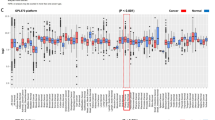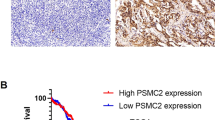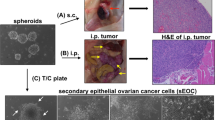Abstract
Although early stage ovarian cancer can be effectively treated with surgery and chemotherapy, the majority of cases present with advanced disease, which remains essentially incurable. Unfortunately, little is known about the genes important for the development and progression of this disease. In this study, the expression of 68 phosphatases was determined in immortalized ovarian epithelial cells (IOSE) and compared to ovarian cancer cell lines. CL100, a dual specificity phosphatase, displayed 10–25-fold higher expression in normal compared to malignant ovarian cell lines. Immunohistochemical staining of normal ovaries and 68 ovarian cancer specimens confirmed this differential expression. Re-expression of CL100 in ovarian cancer cells decreased adherent and non-adherent cell growth and induced phenotypic changes including loss of filopodia and lamellipodia with an associated decrease in cell motility. Induced expression of CL100 in ovarian cancer cells suppressed intraperitoneal tumor growth in nude mice. These results show for the first time that CL100 expression is altered in human ovarian cancer, that CL100 expression changes cell morphology and motility, and that it suppresses intraperitoneal growth of human ovarian epithelial cancer. These data suggest that down-regulation of CL100 may play a role in the progression of human ovarian cancer.
This is a preview of subscription content, access via your institution
Access options
Subscribe to this journal
Receive 50 print issues and online access
$259.00 per year
only $5.18 per issue
Buy this article
- Purchase on Springer Link
- Instant access to full article PDF
Prices may be subject to local taxes which are calculated during checkout








Similar content being viewed by others
References
Alessi DR, Smythe C, Keyse SM . 1993 Oncogene 8: 2015–2020
Alessi DR, Gomez N, Moorhead G, Lewis T, Keyse SM, Cohen P . 1995 Curr. Biol. 5: 283–295
Antonyak MA, Moscatello DK, Wong AJ . 1998 J. Biol. Chem. 273: 2817–2822
Auer KL, Park JS, Seth P, Coffey RJ, Darlington G, Abo A, McMahon M, Depinho RA, Fisher PB, Dent P . 1998 Biochem. J. 336: 551–560
Barnea G, Grumet M, Milev P, Silvennoinen O, Levy JB, Sap J, Schlessinger J . 1994 J. Biol. Chem. 269: 14349–14352
Birrer MJ, Hendricks D, Farley J, Sundborg MJ, Bonome T, Walts MJ, Geradts J . 1999 Cancer Res. 59: 5270–5274
Brondello JM, McKenzie FR, Sun H, Tonks NK, Pouyssegur J . 1995 Oncogene 10: 1895–1904
Charles CH, Abler AS, Lau LF . 1992 Oncogene 7: 187–190
Chu Y, Solski PA, Khosravi-Far R, Der CJ, Kelly K . 1996 J. Biol. Chem. 271: 6497–6501
Cliby W, Ritland S, Hartmann L, Dodson M, Halling KC, Keeney G, Podratz KC, Jenkins RB . 1993 Cancer Res. 53: 2393–2398
Dayton MA, Knobloch TJ . 1997 Recept. Signal Transduct. 7: 241–256
Devesa SS, Blot WJ, Stone BJ, Miller BA, Tarone RE, Fraumeni Jr JF . 1995 J. Natl. Cancer Inst. 87: 175–182
Dodson MK, Hartmann LC, Cliby WA, DeLacey KA, Keeney GL, Ritland SR, Su JQ, Podratz KC, Jenkins RB . 1993 Cancer Res. 53: 4456–4460
Fischer EH, Charbonneau H, Tonks NK . 1991 Science 253: 401–406
Greenlee RT, Hill-Harmon MB, Murray T, Thun M . 2001 Ca-A Cancer Journal for Clinicians 51: 15–36
Gupta S, Barrett T, Whitmarsh AJ, Cavanagh J, Sluss HK, Derijard B, Davis RJ . 1996 EMBO J. 15: 2760–2770
Hendricks DT, Taylor R, Reed M, Birrer MJ . 1997 Cancer Res. 57: 2112–2115
Hoshino R, Chatani Y, Yamori T, Tsuruo T, Oka H, Yoshida O, Shimada Y, Ari-i S, Wada H, Fujimoto J, Kohno M . 1999 Oncogene 18: 813–822
Keyse SM, Emslie EA . 1992 Nature 359: 644–647
Loda M, Capodieci P, Mishra R, Yao H, Corless C, Grigioni W, Wang Y, Magi-Galluzzi C, Stork PJ . 1996 Am. J. Pathol. 149: 1553–1564
Magi-Galluzzi C, Mishra R, Fiorentino M, Montironi R, Yao H, Capodieci P, Wishnow K, Kaplan I, Stork PJ, Loda M . 1997 Lab. Invest. 76: 37–51
Maines-Bandiera SL, Kruk PA, Auersperg N . 1992 Am. J. Obstet. Gynecol. 167: 729–735
Neel BG, Tonks NK . 1997 Curr. Opin. Cell Biol. 9: 193–204
Noguchi T, Metz R, Chen L, Mattei MG, Carrasco D, Bravo R . 1993 Mol. Cell Biol. 13: 5195–5205
Ozols RF, Rubin SC, Thomas G, Robboy S . Epithelial ovarian cancer In W.J. Hoskins, C.A. Perez and R.C. Young (eds) Principles and Practice of Gynecologic Oncology Philadelphia: Lippincott-Raven Publishers 1997 pp 919–986
Sabichi AL, Hendricks DT, Bober MA, Birrer MJ . 1998 J. Natl. Cancer Inst. 90: 597–605
Sajan MP, Standaert ML, Bandyopadhyay G, Quon MJ, Burke Jr TR, Farese RV . 1999 J. Biol. Chem. 274: 30495–30500
Sebolt-Leopold JS, Dudley DT, Herrera R, Van Becelaere K, Wiland A, Gowan RC, Tecle H, Barrett SD, Bridges A, Przybranowski S, Leopold WR, Saltiel AR . 1999 Nat. Med. 5: 810–816
Shayesteh L, Lu Y, Kuo WL, Baldocchi R, Godfrey T, Collins C, Pinkel D, Powell B, Mills GB, Gray JW . 1999 Nat. Genet. 21: 99–102
Sun H, Charles CH, Lau LF, Tonks NK . 1993 Cell 75: 487–493
Sun H, Tonks NK, Bar-Sagi D . 1994 Science 266: 285–288
Tetsu O, McCormick F . 1999 Nature 398: 422–426
Tonks NK, Neel BG . 1996 Cell 87: 365–368
Watsuji T, Okamoto Y, Emi N, Katsuoka Y, Hagiwara M . 1997 Biochem. Biophys. Res. Commun. 234: 769–773
Webb CP, Van Aelst L, Wigler MH, Woude GF . 1998 Proc. Natl. Acad. Sci. USA 95: 8773–8778
Wiener JR, Kassim SK, Yu Y, Mills GB, Bast Jr RC . 1996 Gynecol. Oncol. 61: 233–240
Wu J, Lau LF, Sturgill TW . 1994 FEBS Lett. 353: 9–12
Acknowledgements
The ovarian cell lines used in this study were obtained as generous gifts from Dr Scott Rose (University of California, San Diego, CA, USA), Dr David Spriggs (Memorial Sloan Kettering Cancer Center, New York, NY, USA), Dr Jacques DeGreve (AZ-VUB-Oncologisch Centrum, Brussels, Belgium), and Dr Louis Dubeau (Norris Cancer Center, University of California, Los Angeles). The human cyclin D1 promoter plasmids were derived from fragments provided by Dr A Arnold and Dr R Pestell and constructed by Dr Osami Tetsu with Dr Frank McCormick. Protein lysates from HOSE cells were a kind gift of Dr Mok (Harvard University, Boston, MA, USA). We thank these individuals for their generous gifts. We thank Aaron Bell for his expert technical assistance. This work was supported in part by grants DK52825, CA88906 and DAMD-99-17-9426 to P Dent.
Author information
Authors and Affiliations
Corresponding author
Rights and permissions
About this article
Cite this article
Manzano, R., Montuenga, L., Dayton, M. et al. CL100 expression is down-regulated in advanced epithelial ovarian cancer and its re-expression decreases its malignant potential. Oncogene 21, 4435–4447 (2002). https://doi.org/10.1038/sj.onc.1205542
Received:
Revised:
Accepted:
Published:
Issue Date:
DOI: https://doi.org/10.1038/sj.onc.1205542
Keywords
This article is cited by
-
The impact of phosphatases on proliferative and survival signaling in cancer
Cellular and Molecular Life Sciences (2018)
-
The regulatory roles of phosphatases in cancer
Oncogene (2014)
-
Diversity and specificity of the mitogen-activated protein kinase phosphatase-1 functions
Cellular and Molecular Life Sciences (2013)
-
Ovarian cancer molecular pathology
Cancer and Metastasis Reviews (2012)
-
Inside the human cancer tyrosine phosphatome
Nature Reviews Cancer (2011)



